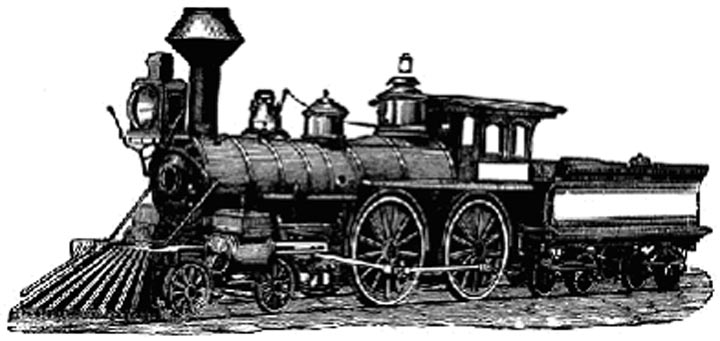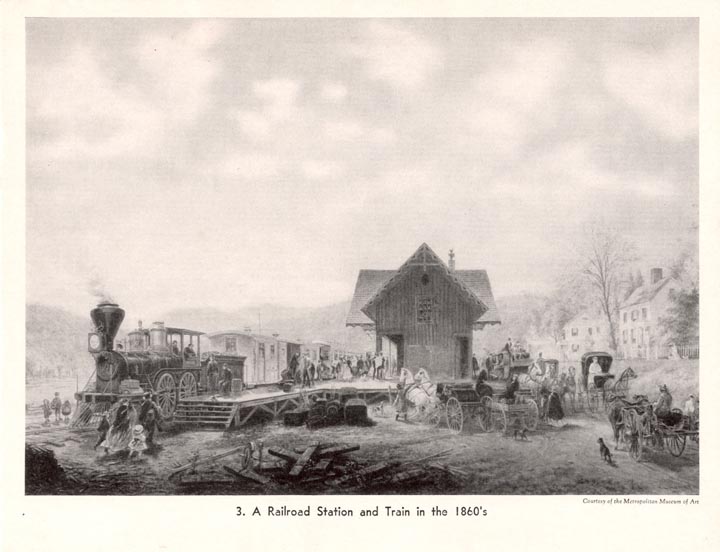Association of American Railroads Teacher’s Kit – Part III
Presented by Bill Fuller
In the early 1940s, the Association of American Railroads (AAR) offered a Teacher’s Kit for use in teaching public school students about the transportation industry. Of course, in the mind of the AAR, transportation equaled railroads, and the kit includes over 50 photographs of railroad scenes. Each photograph is accompanied by a descriptive story, each of which becomes a short history lesson in the place of railroading in American culture and economy. A complete copy of the original kit is in the archives of the High Plains Western Heritage Center, Spearfish, South Dakota. Its contents have been scanned and reprinted for public viewing in the Heritage Center by TCA member Bill Fuller, who has also provided a copy to e*Train. Each new issue will feature one of the photographs and its story.
The “East and West Railroad” or “E & W” shown in the photographs never existed. Actual railroad names were replaced in the photographs probably to avoid the appearance of giving free advertising to some railroad lines while slighting others.
What is the Association of American Railroads?
The 1941 – 1943 Teacher’s Kit containing these photographs and descriptive text was published by the Association of American Railroads (AAR). The following information about this organization is quoted from the AAR Web sites About AAR–AAR History and About AAR , retrieved November 23, 2004:
The AAR was formed in 1934. But its history really goes back much further–all the way to 1867 when the Master Car Builders Association was formed to conduct experiments aimed at standardizing freight cars.
Soon other organizations representing other railroad subjects were formed. By the early 1930s, there was an alphabet soup of organizations representing the industry. Included were the Association of Railway Executives, the American Railway Association, the Bureau of Railway Economics, the Railway Treasury Officers Association, the Railway Accounting Officers Association and the Bureau for the Safe Transportation of Explosives and other Dangerous Articles. These and others were folded into the new Association of American Railroads, when it was established on October 12, 1934.
The unification of rail associations was a fallout from the Great Depression. In 1933 the Rail Transportation Act was passed and a Federal Coordinator of Transportation was appointed to deal with depression-era problems affecting railroads. Beset by a plethora of voices representing the railroad industry, Coordinator Joseph B. Eastman – with the support of President Franklin D. Roosevelt – soon recommended that railroads unify into one organization that could speak for the entire industry, leading directly to creation of the AAR.
AAR members include the major freight railroads in the United States, Canada and Mexico, as well as Amtrak. Based in Washington, DC, the AAR is committed to keeping the railroads of North America safe, fast, efficient, clean, and technologically advanced. Much of the AAR focus is on Washington, bringing critical rail-related issues to the attention of Congressional and government leaders.
The AAR is also very much involved in programs to improve the efficiency, safety and service of the railroad industry. Two AAR subsidiaries – the Transportation Technology Center, Inc., and Railinc – ensure that railroads remain on the cutting edge of transportation and information technology.
Railroads are the vital link to our economic future. More than 40 percent of all US freight moves by rail – more than from any other single mode of transportation. As Fortune Magazine recently observed, “While Internet companies scramble for sound business footing, many of America’s trains are running on Internet time – at a profit.”
© 2004 AAR 50 F Street, NW, Washington, DC 20001-1564 •• 202-639-2100
Used with permission”
Story # 3
Great and many were the changes in railway transportation from the 1830’s to the 1860’s, and great and many indeed have been the changes since then.
This is a typical railway station scene in the 1860’s. With the arrival and departure of each passenger train, the station platform and grounds presented a scene of great animation. At the right of the picture is a motley assortment of conveyances—an ox cart, a drayman’s wagon, smart carriages, a hansom cab and a stagecoach—typical of the road vehicles of that period.
Before railroads were introduced, stagecoaches provided passenger and mail service for long distances, with many changes of horses and drivers and many stops for rest, refreshments and sleep en route. When the railroad was opened, many stagecoaches turned to providing service between the railroad and communities located off the rail route.
Contrast the passenger train in this picture with the trains of today.
The locomotives of that day were much smaller than those now in use. Most of them burned wood for fuel. A conspicuous feature of the wood-burning locomotive was its large “balloon” shaped smokestack, which was often fitted with a screen to prevent sparks from flying out and setting fire to the wooden cars, to the wood in the tender or to buildings, bridges or forests along the route. In extremely cold weather, the little locomotives had much difficulty in keeping up steam, and few of them maintained their schedules. Sometimes in blizzard weather they became stalled in snow drifts for hours or even days. When conditions were favorable, passenger trains in those days usually traveled about fifteen or twenty miles an hour.
The light wooden passenger cars were a great improvement over those of a generation before, but they lacked many of the comforts of the all-steel passenger cars of today. They were heated by wood-burning or coal-burning stoves. In some cars there were stoves at either end; in others there was one stove in the center. Stoves did not distribute heat uniformly throughout the car, and passengers frequently complained that the cars were either too hot or too cold.
Ventilation was poor, especially when the weather did not permit the windows to be opened. There were no screens, so that when the windows were opened, smoke, cinders and dust entered the car to the discomfort of the passengers.
Cars were lighted by flickering coal-oil lamps and so dimly that reading by lamplight was almost out of the question.
Passenger cars in the 1860’s were not equipped with vestibules, or enclosed platforms, as they are today, and it was dangerous for passengers to go from one car to another when the train was in motion.
Club, lounge and observation cars were then unknown, and there were very few sleeping cars.
The roadbeds of even the best railroads were lightly and crudely built when measured by modern standards, and trains did not ride nearly as smoothly as they do today. Moreover, there were no signal systems, and few safety devices.
Not only have the speed of trains and the comforts, conveniences and safety of passenger travel been greatly increased since the period depicted by this picture, but the cost of railway travel has been very substantially reduced since then.
Railway transportation revolutionized life in the older parts of the country and opened up vast regions for settlement.
Wherever the rails were laid and the “Iron Horse” appeared, communities took on new life and a new outlook. As the rails were pushed through the mountains and valleys and across the prairies and plains, farms were opened; homes, schools, churches, stores and mills were established; forest and mineral resources were developed; and the foundations were laid for the agricultural and industrial development which has made the United States the great nation it is today.







